Review: Mammoth Cave National Park - Broadway Tour
We really enjoyed the Broadway Tour hike and all the information the ranger shared with us. The area was protected by the Mammoth Cave National Park Association in 1926 and officially became the 26th National Park in 1941. Mammoth Cave is the world’s longest known cave system. They think it is 800-1000 miles long, but don’t really know as they keep finding new passageways and connecting them to the 440 miles of cave that are already excavated. There are actually ways you can participate in exploring and helping to excavate, but we didn’t look into those at all. About 80% of the cave system is underneath the national park, which is 53 acres. There are multiple levels; I think they mentioned five. The other 20% of the cave is under private land, including one entrance.
We met with our group behind the Visitor Center, and it was pretty big, maybe twenty people. Only one other kid, slightly older than mine, probably 7 or 8 and remarkably well-behaved. The tour starts going down a wide trail behind the visitor center to the cave entrance, which is stairs leading down next to a waterfall.

The pathways inside the cave were wide and surprisingly dry. I had been years ago and remembered it with stalactites, stalagmites, and tight spaces but that must have been a very different tour. I asked the guide if the Mammoth Passage Tour was substantially different, and it’s not. It starts the same way then turns off to the right for a bit, but it looks very much the same. That tour doesn’t go into as much depth as the Broadway.

Because of Covid, only these two tours are being offered right now. Normally, there are river tours, tours where you have to crawl through narrow spaces, and ones where you explore in small groups with lanterns. They usually take guests on about 10-12 miles of tours compared to the 1.5 miles available now. The routes open now lead to huge cavernous rooms where there is plenty of space to spread out while the ranger is talking. While the geologic information was interesting, we were all more interested in the history, and there were a few things that our kids really enjoyed learning and some that would be better for slightly older kids.
Bats are some of my favorite animals. They are interesting for so many different reason plus they eat mosquitos, which gets them all kinds of props in my book. Anyhow, there used to be so many bats inside Mammoth Cave that the ranger said it looked like the walls were moving and alive. Super creepy if you are working only with a torch! Now, there are hardly any bats. We didn’t see a single one. Indiana Bats were the most common here and they are now on the endangered species list. There’s a real issue with White Nose Syndrome, which has been found in the park. This disease is a fungus that has killed millions of bats since it was identified in 2006. When you leave the cave tour, you have to walk across a spongy soapy path to clean your shoes. This has something to do with preventing the spread of White Nose Syndrome.
One of the things my kids found fascinating is the fact that they used to make gunpowder from the bat poop in the cave. The ranger told us that one in five rounds from the War of 1812 were made from the gunpowder produced from the saltpeter mined in Mammoth Cave. So, the many bats in Mammoth Cave meant a LOT of bat guano, which piled up on the cave floor. People figured out that it was possible to mine the bat guano, leach it of minerals so that it’s mostly potassium nitrate left, which is the saltpeter. This then gets mixed with sulfur and charcoal to make gunpowder. After the War of 1812 ended, the price of saltpeter dropped by about 90%, making it less than profitable to mine, even though most of the work was being done by slaves. It had been up to $1/pound and was suddenly 10 cents/pound.
The last private owner of Mammoth Cave was a doctor named John Croghan, who wanted to cure tuberculosis. Because the environment inside the cave is free from outside pollutants and had what he thought was optimal humidity, he hoped it could cure a disease that had no cure at all in 1842-3, when he was running his hospital in the cave. He had fourteen stone huts built on two levels of the cave, and the patients lived in them, basically in the dark, until their lung disease was too far gone, some of them as long as eight months. Three of them actually died in the cave. The way the ranger told it, the whole thing sounded insanely creepy. Tourists kept pouring into the cave, led by guides with lanterns, and they would walk past the huts the same way we did. So it would be mostly dark, with eerie light and shadows, and suddenly you’d see gaunt figures in white nightgowns moving in the distance like ghosts.

Back when people would take torches and lanterns and build fires down in the cave, the soot collected on the ceiling and now there are lots of cool shapes in the black up there. We saw Santa’s sleigh with one of the reindeer.

There was also a trick the ranger did with the lantern that was supposed to make it look like a coffin opening, but I couldn’t see it. Maybe vampire fans would enjoy this…do the Twilight vampires sleep in coffins?

At another part of the cave, the ceiling is completely black, with little white specs of rock showing through and it looks like the night sky.

Another cool thing is the Methodist Church room inside the cave. It’s a huge space and our ranger stopped there to talk both directions. The cave is a steady 54 degrees, and at some point one summer when people were sweating in church, they realized they could hold services inside the cave and be far more comfortable, so they did.

On the geologic side, the most fascinating thing was that they have found fossils from more than forty species of shark in the limestone of the cave walls.
I panicked at one point that we had left the water bottle behind and was going to ask the second ranger to go back for it, but we had it. About that same time, I saw the other woman with a little boy go talk to him. I think they had left an inhaler or something important back at their car, and he led them directly out.



